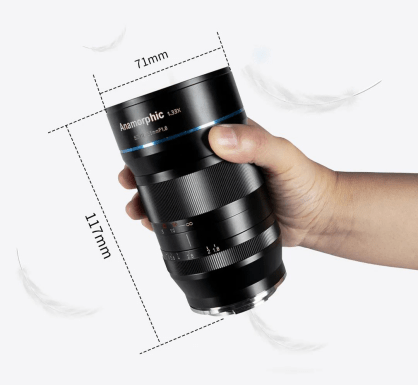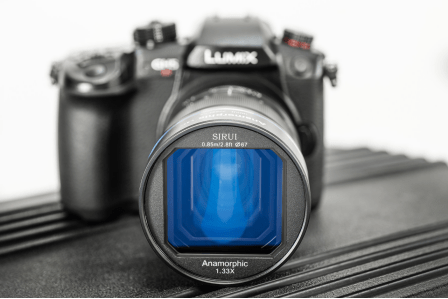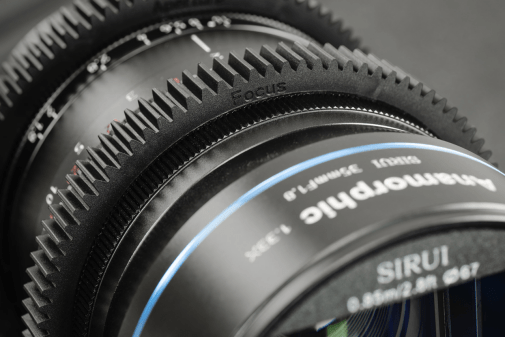Compared with ordinary lenses, anamorphic lenses can expand the frame in the horizontal direction, accommodate more shooting materials, and can output shots with a wide-format specification ratio without cropping, and accompanied by backlight streaks, oval bokeh and other film texture elements that are difficult to achieve in the later stage. It's a high-end lens that film crews love.
The popular anamorphic lenses on the market are expensive and bulky, and generally only professional teams or enthusiasts can afford the price. However, the SIRUI anamorphic lens breaks the existing pattern with a lighter and more cost-effective attitude, making the anamorphic lens accessible to public enthusiasts from far away. It's a new chapter of civilian-level anamorphic lens.

The lens body is made of aluminum alloy material, and the key parts such as focusing are made of precision copper material. The lenses are made of German Schott glass with high-definition nano-coating. The front end of the lens is coated with a waterproof and anti-fouling film.
The lens weighs about 700g and has a length of about 117mm; 13 lens elements in 9 groups, 10 aperture blades; apertures from F1. 8 to F16. The aperture is a stepless; the focusing method is purely manual, the closest focusing distance is 0.85m to infinity, and the stroke is about 191.2°; the original M4/3 format of the system can basically cover the APS after adapting to the APS-C camera through the adapter.
The horizontal equivalent angle of view of SIRUI 50mm anamorphic lens is 37.5mm, and that of view of 35mm anamorphic lens is 26.3mm. In contrast, the depth of field at the 50mm focal length is shallower, and the oval bokeh is more obvious; the framing field at the 35mm focal length is wider.
If you want to highlight characters, render emotions, and highlight the atmosphere of the environment, the 50mm focal length is a good choice. If you want to show the magnificence of the scene, better integrate the scene and people, and accommodate more shooting materials, the 35 focal lengths can give you a wider range of scene applications.

Left:50mm Right:35mm
In actual shooting, only one focal length will be very limited. The 50mm focal length and the 35mm focal length are both indispensable golden focal lengths that are closest to what the human eye perceives. Combining the two can better show the work and make the switch between the main close-up and the scene display more freely.
Cropping will destroy the original composition, waste material on the top and bottom edges, and seriously lose image quality. After installing the SIRUI 35mm/F1.8 1.33X anamorphic lens, the sensor area can be better used, 33% more material in the horizontal direction, and 2.4:1 wide-format works can be output without cropping.
Compared with ordinary lens frame-blocking, the SIRUI anamorphic lens has a shallower depth of field at the same horizontal equivalent focal length. If you want the same depth of field, the SIRUI anamorphic lens can obtain a wider image field and accommodate more materials.
And the characteristics of the anamorphic lens are not only wide-format, but also accompanied by unique optical characteristics such as backlight drawing, oval bokeh, etc., which is also a film texture that is difficult to achieve in the later stage.

The original M4/ 3 mount of the lens, due to the 1.33 times stretching in the horizontal direction, the horizontal equivalent focal length is (35*2)/1.33=52.6mm. The vertical equivalent focal length remains unchanged, which is 35*2=70mm.
With Sirui's special adapter ring, it can be adapted to Sony E, Canon EF-M, and Nikon Z-mount cameras. Since the APS-C format camera is converted, the horizontal equivalent focal length is (35*1.5)/1.33=39.4mm, and the vertical equivalent focal length remains unchanged, which is 35*1.5=52.5mm.
| Focal length | 35mm |
| Max aperture | f/1.8 |
| Min aperture | f/16 |
| Angle of view | Unspecified |
| Format | APS-C / Super 35mm |
| Mount | Micro Four Thirds (Canon EF-M, Nikon Z, Sony E with adapters) |
| Lens type | 1.33x Anamorphic |
| Focus type | Manual Focus |
| Focus throw | 191.2° |
| Min focus distance | 85cm |
| Optics | 13 elements in 9 groups |
| Filter size | 67mm |
| Aperture blades | 10 |
| Dimensions | 71 x 117mm |
| Weight | ~700g |
The lens is native to the MFT frame, and can basically cover the APS-C frame after using the adapter ring. If you need to use it on a full-frame camera, please turn on the APS-C frame mode on the camera body, and you can use it normally.
At present, the two anamorphic lenses launched by SIRUI are mainly aimed at the huge mirrorless market, so they are also aimed at the mainstream mirrorless camera mounts, and there are currently no mounts for SLR or professional movie cameras.
*Please look forward to more mount or full frame versions in the future.

The screen ratio of most cameras is 16:9, and the SIRUI anamorphic lens is squeezed into the 16:9 screen by shooting at a 2.4:1 ratio, so it is necessary to enable the anti-squeeze mode on the camera body, and choose 2.4: 1 scale to view. If the camera does not have this option, you need an external monitor (such as ATOMOS) to select 2.4: 1 ratio or 1. 33x anamorphic ratio for viewing.

Adobe Premiere Pro / Final Cut Pro / iMovie / DaVinci Resolve and other software can be used for post-processing, click Edit - Modify - Interpret Material - Pixel Aspect Ratio and select Distortion 1.33x.
SIRUI 35mm/F1.8 anamorphic lens is a purely manual lens, without electronic contacts and without image stabilization.
For the anamorphic lenses on the market, the manual focus is generally used, which can be used to adjust the focus more accurately according to the scene change. The follow focus gear equipped by SIRUI can be used to perform operations such as focus tracking.
The anamorphic extension lens installed in front of the lens on the market can adapt to more lenses, but it still faces the problems of needing secondary focusing, increasing the size of the device, and reducing the sharpness of the picture, and the price of the combination lens + lens is much higher than SIRUI anamorphic lenses. Therefore, an anamorphic lens with more convenient operation, higher cost performance and better quality will be a better choice.
Although the SIRUI anamorphic lens is mainly used for video shooting, it still has the function of shooting wide-format high-resolution photos, which can meet the needs of users for film-like photos. In addition, SIRUI specially customizes the focus gear and aperture adjustment gear, and presents them as accessories to buyers, so that everyone can use them selectively.

When you are used to seeing the same 16: 9 photos, the photos taken by the anamorphic lens may bring you a unique movie look, and the 2.4: 1 wide format is closer to the perspective of the human eye, giving you an immersive feeling.

Compared with other anamorphic lenses, the SIRUI anamorphic lens has higher sharpness and softer out-of-focus, and the photos under the backlight streaks show a richer film quality.
13. How to replace the adapter ring? How to install the lens?
If you purchased an adapter ring, you need to manually replace the installation. First, remove the 4 Phillips screws on the bayonet, fit the limit pin of the adapter ring to the bayonet groove, and twist it left and right to check whether it is secure. Reinstall the 4 Phillips screws that were removed before into the corresponding holes, and then tighten and fix. Note that the rest of the screws cannot be removed, otherwise the lens will be damaged.
Align the white point of the lens with the white point of the camera body. After inlaying, twist it clockwise until it is locked. At this time, the SIRUI logo is facing up.


















Just a question on resolution, so I’m shooting still photos using my Sirui lens on my 20MP Panasonic GH5, normally my images (including my squeezed images) are 5184×3888 giving me a 20MP image but with my anamorphic images if I go into Photoshop and use Image Resize to multiple the horizontal axis by 1.33x, I get a 6894×3888 image which is more than 20MP – what’s happening there? Am I getting a true higher resolution image or is there interpolation going on – doesn’t make sense? Thanks.